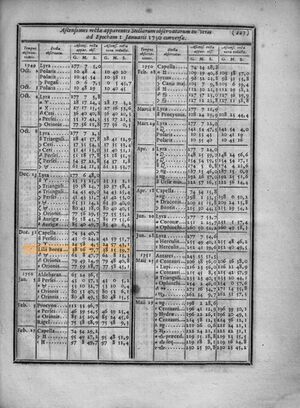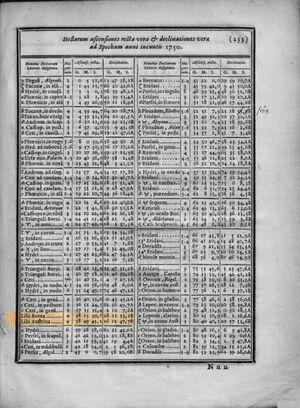Lilii Borea

Ignace-Gaston Pardies introduced a new (now obsolete) constellation Lilium, the fleur-de-lis of France, 1674. He had reused four stars in the north of Aries which were unnamed in Antiquity and therefore subject of various namings in Early Modern Ages. The individual stars of the Lily were unnamed.
In the Almagest listed as "The 4 stars over the rump [of the Ram]", outside the constellation image.
Etymology and History
Lilium Constellation
Ignace-Gaston Pardies introduced a new (now obsolete) constellation Lilium, the fleur-de-lis of France, on plate 2 of his Globi coelestis in tabulas planas redacti descriptio atlas published posthumously in 1674, although he did not attach a name to the image. He had reused four stars in the north of Aries from which Petrus Plancius in 1613 had previously formed Apes, the Bee to model the constellation.
In 1679, Augustin Royer published his Cartes du ciel réduites en quatre tables and an accompanying star catalogue, both of which contain the constellation Lilium, this time carrying the name and the translation "La Fleur de lys".
In 1730, the constellation Lilium also appeared in Mercurii philosophici firmamentum firmianum descriptionem et usum globi artificialis coelestis by Thomas Corbinian, a German-Austrian monk who lived in Augsburg and Salzburg.
In 1795, Jean Nicolas Fortin published his commentary to Flamsteed's Atlas Coelestis and mentions the Fleur de Lis:
La tête de Méduse A l’Orient du triangle, on remarque un groupe de cinq étoiles, formant la tête de Méduse; la plus orientale est de la seconde grandeur, & se nomme Algol; cette étoile est singuliere en ce qu’elle diminue de grandeur & de lumiere dans l’espace de 2 jours 20 heures 49 minutes 1 seconde. Si l’on prend le triangle & la tête de Méduse pour les deux extrémités de la base d’un triangle équilatéral dont le sommet seroit au Midi, on remarquera trois étoiles dont une est de la troisieme grandeur, c’est la petite Constellation de la Mouche, ou le Lys.
English translation:
The head of Medusa To the east of the triangle we see a group of five stars, forming the head of Medusa; the easternmost is of the second magnitude, and is called Algol; this star is singular in that it diminishes in magnitude and luminosity in the period of 2 days 20 hours 49 minutes 1 second. If we take the triangle and the head of Medusa for the two extremities of the base of an equilateral triangle whose summit would be at Midday, we will notice three stars of which one is of the third magnitude, it is the small Constellation of the Fly, or the Lily.
Star Names
Lacaille named its two brightest stars Lilii Borea and Lilii Austrina (i.e. in the north and south of the lily)
In his Astronomiæ fundamenta novissimis solis et stellarum observationibus stabilita published in 1757[1], Lacaille presented several tables, e.g. a star catalogue (Tabula exhibens Stellarum afcenfiones rectas veras declinationes veras) and a list of right ascensions of selected stars (De veris aliquot Stellarum afcenfionibus rectis fæpiùs) where he calls the two star names Lilii Borea and Lilii Austrina.
| RA1750 | DEC1750 | identification | |
|---|---|---|---|
| Lilii Borea | 38° 15' 39."7 | 28° 11' 33."1 | 39 Arietis (a star of Lilium) |
| 39 Ari (Stellarium) | 38.°28
38° 17' 1".6 |
28° 11' 34."6 | |
| Lilii Austrina | 38° 49' 45."2 | 26° 12' 47."7 | 41 Arietis (a star of Lilium) |
| 41 Ari (Stellarium) | 38.°84
38° 50' 37" |
26° 12' 52."1 |
Lacaille also published the Ephemerides des mouvemens celestes, pour dix annees, depuis 1765[2] and names these two stars La Boreale a la fleur de Lys (The Northern one of the Lily) and L'Australe a la fleur de Lys (The Southern one of the Lily).
The modern designations of these two stars are 39 and 41 Arietis. In 2017 the IAU WGSN adopted Lacaille’s name Lilii Borea for 39 Arietis. They gave 41 Arietis the name Bharani after the second nakshatra (lunar mansion) in Hindu astronomy, consisting of 35, 39, and 41 Arietis.
Mythology
The Lily was an emblem of France: the "Fleur-de-lis" (Unicode U+269C ⚜) is a heraldic symbol. In particular, in the time of Louis XIV this symbol was dedicated to the French king as the country's representative.
IAU Working Group Star Names
The name was applied to the 4.52 mag-star HR 824 (39 Ari) in the IAU-CSN in 2017.
Weblinks
- Ridpath, Ian, Star Tales: Lilium, the fleur-de-lis
Reference
- Warner, D. J., (1979) Sky Explored: Celestial Cartography 1500–1800, Alan R. Liss, Inc., New York / Theatrum Orbis Terrum Ltd., Amsterdam, p. 213.
- Kanas. N., (2007) Star Maps: History, Artistry, and Cartography, Praxis, Chichester, p. 159.
- ↑ Lacaille, N. L. (1757). Astronomiae fundamenta novissimis solis et stellarum observationibus stabilita, Lutetiae in Collegio mazarineo et in Africa ad caput Bonae Spei peractis a Nicolao Ludovico de La Caille. Digitalized by GoogleBooks, here p. 227 and 233.
- ↑ Lacaille (1765) Ephemerides des mouvemens celestes, pour dix annees, depuis







